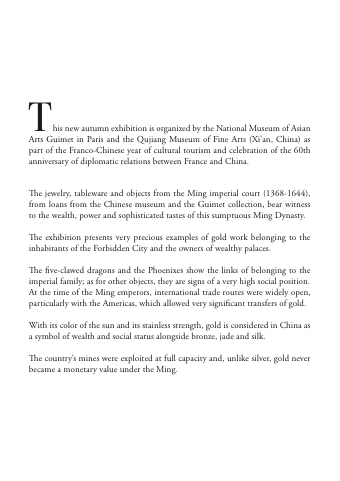Page 226 - B-ALL 50 ENG
P. 226
This new autumn exhibition is organized by the National Museum of Asian Arts Guimet in Paris and the Qujiang Museum of Fine Arts (Xi’an, China) as part of the Franco-Chinese year of cultural tourism and celebration of the 60th anniversary of diplomatic relations between France and China.
The jewelry, tableware and objects from the Ming imperial court (1368-1644), from loans from the Chinese museum and the Guimet collection, bear witness to the wealth, power and sophisticated tastes of this sumptuous Ming Dynasty.
The exhibition presents very precious examples of gold work belonging to the inhabitants of the Forbidden City and the owners of wealthy palaces.
The five-clawed dragons and the Phoenixes show the links of belonging to the imperial family; as for other objects, they are signs of a very high social position. At the time of the Ming emperors, international trade routes were widely open, particularly with the Americas, which allowed very significant transfers of gold.
With its color of the sun and its stainless strength, gold is considered in China as a symbol of wealth and social status alongside bronze, jade and silk.
The country’s mines were exploited at full capacity and, unlike silver, gold never became a monetary value under the Ming.


